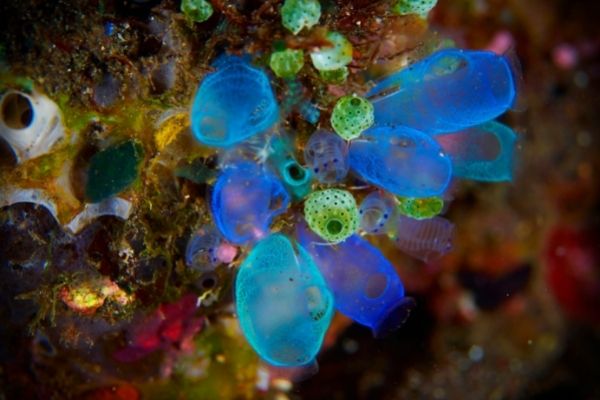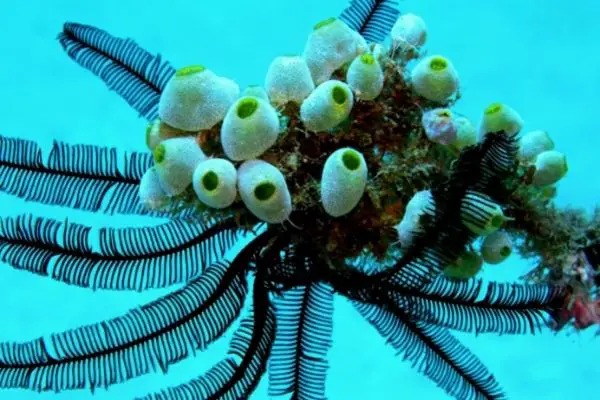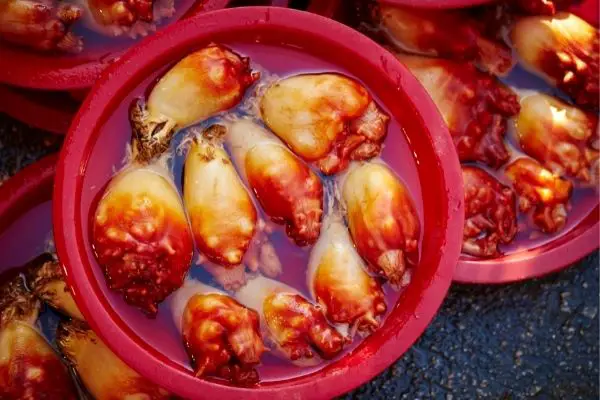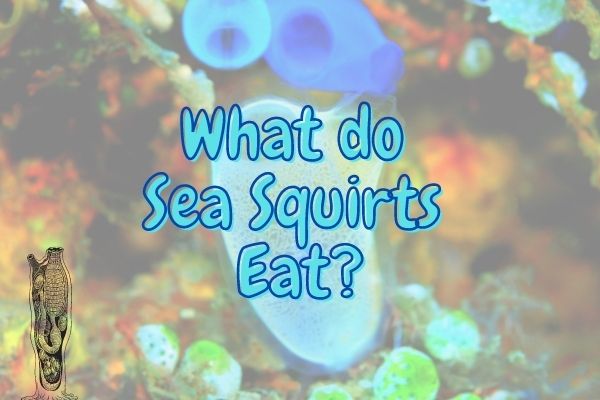Sea squirts are filter feeders that consume plankton and detritus. They play an important role in the ocean food web by removing these particles from the water column and providing a nutritious meal for many other animals.
Sea squirts are opportunistic feeders that will eat anything they can get. In the wild, they mainly eat small things that float in the water, such as plankton and bacteria. The young sea squirt larvae usually do not eat at all during their swimming stage until they settle on a rock somewhere.
Whereas they mostly eat living things like algae and zooplankton, they do also eat dying or dead animals in the form of detritus. However, true decomposers are the bacteria and fungi that live in the sea squirts’ digestive system and perform the final steps of digestion.
Their diet changes between seasons, as different food types become more abundant, or as they grow bigger and can filter out larger food items like more zooplankton and smaller crustaceans.
Some sea squirts have developed a relationship with algae that live in their skin and provide them with nutrients. This is similar to the relationship between algae and corals.
Contents
Why are Sea Squirts Important for the Ecosystem?
Sea squirts play an important role in the ecosystem as filter feeders. They consume plankton and detritus, which helps to keep the water clean. In addition, their consumption of plankton affects the food chain by reducing the amount of food available for other animals further up the food chain.
Filter feeding also has a positive effect on water quality by removing excess nutrients from the water and increasing the water flow rate.
This can help to prevent algae blooms, which can have a negative impact on aquatic ecosystems. Coral reefs thrive in low nutrient waters with few algae and a high water flow rate, so corals enjoy the presence of sea squirts.
In addition to their role in filtering water, sea squirts also provide a home for other animals. Many small animals such as shrimp (e.g. hobbit shrimp) live among the sea squirts and use them for shelter and protection from predators.
Are sea squirts invertebrates?
The sea squirt, usually referred to as a “tunicates” (from the Latin tunica meaning “a garment”) is a member of the phylum Chordata. This means that even though they look very different from us, they are in the same group as humans!
Sea squirts are invertebrate chordates with a notocord and a dorsal hollow nerve cord. The majority of tunicates are sessile filter feeders, and some are parasitic on other organisms.
Sea squirts lack well-developed organs and are internal fertilizers that release eggs into the water column where they develop into free-swimming larvae called trochophores.
The larvae later settle onto substrates to start feeding passively by filtering plankton from the surrounding water before metamorphosing into adults.

The animal alternates between two feeding methods: active filtration of small food particles through its oral siphon in one direction and passing water through its pharynx in the opposite direction to remove larger food particles.
This enables sea squirts to concentrate their food despite living at the base of aquatic food webs dominated by large herbivorous zooplankton (such as jellyfish, ctenophores (comb jellies) and various species of diatoms).
In addition to using their pharynx to help filter prey from water currents, sea squirts also use it for locomotion. The animal can contract its pharynx causing it to become shorter and thicker thereby propelling itself forward in much the same way as some types of worms do.
However, they still remain attached to the bottom and only use this to direct themselves toward food sources.
This type of propulsion makes sense only when compared with other sedentary filter feeders such as sponges which appear unable to move anywhere but can still find enough small food items within their local environments via passive means if nothing else.
Where do sea squirts live?
Sea squirts live in the ocean. They are usually found near coral reefs.
Sea squirts are found all over the world in marine habitats. They are often found in shallow water near the shore, but can also be found in deeper waters.

Sea squirts have a soft body and usually attach themselves to rocks or other hard surfaces.
Their stationary attachment allows them to get their food by filtering water through their bodies.
Are Sea Squirts Carnivores, Herbivores or Omnivores?
Sea squirts are omnivores because they eat phyto- and zooplankton.
What Type of Consumer is a Sea Squirt?
Sea squirts are consumers because they eat other living things. Some sea squirts also obtain some of their energy via symbiotic algae in their skin. Sea squirts are omnivores, which means that they eat other animals and algae. Only plants as well as some bacteria and algae are producers.
Can Sea Squirts be Considered Decomposers?
No. Sea squirts are not true decomposers, but they can function as detritivores in the ocean.
Sea squirts do not eat dead or decaying matter and are therefore not decomposers. The bacteria in the gut of the sea squirt plays a very important role for their digestion and these microorganisms may be considered true decomposers.
Are Sea Squirts Autotrophs or Heterotrophs?
Sea squirts are heterotrophs because they eat other living organisms. Practically no animals are autotrophic because animals do not get their energy directly from the sun as plants do. That is, animals like the sea squirt cannot make their own energy!
Where are Sea Squirts in the Food Chain?
Like other animals, sea squirts are consumers. Animals that eat other living things are primary consumers and are placed on the second trophic level in the energy pyramid.
The energy transferred by the sea squirt is the energy from the animals they eat. This energy is transferred to the animals that eat the sea squirt, for example a fish.
Food chains simply demonstrate how energy moves from one organism to the next, in a straight line.
What Animals Prey on Sea Squirts?
Predators of the sea squirt include leatherback sea turtles, fish, crustaceans, starfish and sea urchins. These animals will seek out and eat sea squirts in the wild.
But as for sea squirts that are kept in aquariums, they experience no real threats.

Some sea squirts are also considered delicacies among humans and are eaten regularly in regions where they are most abundant such as South Korea.
How do sea squirts protect themselves?
Most sea squirts are poisonous to some extent and will harm potential predators when eaten. Some sea squirts actively protect themselves by releasing a toxin that paralyzes predators nearby.
Conclusion
Today I have looked into the habitat, feeding behaviour and breeding habits of the sea squirt, and how the different behaviours interact with one another.
Sea squirts are a very interesting group of animals that live on the sea floor, in rocky reefs, and in tide pools. They are filter feeders, and are often found feeding on plankton, detritus and other substances in the water column.
Some tropical sea squirts are very beautiful due to their interesting bright colour patterns, such as blue and purple. These can be kept in an aquarium.
Sea squirts can also reproduce sexually and asexually. Asexual reproduction involves sea squirts breaking off a piece of colony and attaching it to another rock.
Sexual reproduction is haploid and involves sea squirts releasing sperm and eggs into the water where fertilisation occurs, and the resulting larvae are free floating.
Sea squirts play an important role in the ecosystem. As filter feeders they remove plankton from the water and this assists with maintaining a balanced ecosystem, but they can become too much!
If sea squirts remove too much plankton, the ecosystem can suffer as other animals, such as small fish, are dependent on them. On the other hand, they can benefit coral reefs by removing excess nutrients and bacteria that are problematic for coral growth.




